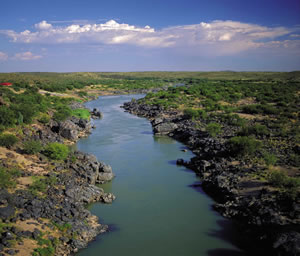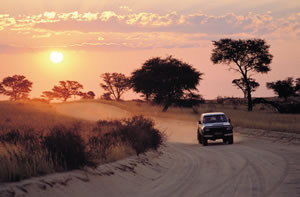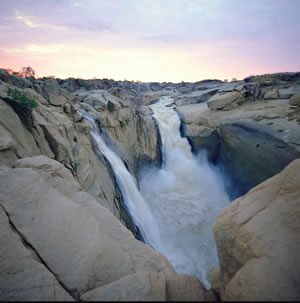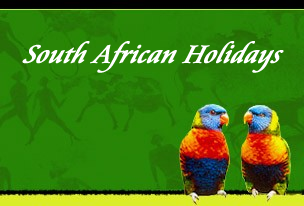The Northern Cape province lies to the south of its most important asset, the mighty Orange River,  which provides the basis for a healthy agriculture industry. The landscape is characterised by vast arid plains with outcroppings of haphazard rock piles. The cold Atlantic Ocean forms the western boundary.
which provides the basis for a healthy agriculture industry. The landscape is characterised by vast arid plains with outcroppings of haphazard rock piles. The cold Atlantic Ocean forms the western boundary. This region covers the largest area of all the provinces and has the smallest population. The major airports are situated at Kimberley, the capital, and Upington. The Northern Cape is serviced by an excellent road network, which makes its interior easily accessible from South Africa's major cities, harbours and airports.
Important towns are Upington, centre of the karakul sheep and dried fruit industries, and the most northerly wine-making region in South Africa; Springbok in the heart of the Namaqualand spring-flower country; Kuruman founded by the missionary Moffat; De Aar, hub of the South African railway network; Sutherland, the coldest town in the country; and the sheep-farming towns of Carnarvon, Colesberg, Kenhardt and Prieska.
Apart from a narrow strip of winter-rainfall area along the coast, the Northern Cape is a semi-arid region with little rainfall in summer. The weather conditions are extreme cold and frosty in winter, and extremely high temperatures in summer. 
The largest part of the province falls within the Nama-Karoo biome with a vegetation of low shrubland and grass, and trees limited to water courses. The area is known world-wide for its spectacular display of spring flowers which, for a short period every year, attracts thousands of tourists.
This biome is home to many wonderful plant species, such as the elephant's foot (halfmens), tree aloe (kokerboom) and a variety of succulents.
The province has several national parks and conservation areas. The Kalahari Gemsbok National Park, together with the Gemsbok National Park in Botswana, is Africa's first transfrontier game park, known as the Kgalagadi Transfrontier Park. It is one of the largest nature conservation areas in southern Africa, and one of the largest remaining protected natural ecosystems in the world.
The Park provides unfenced access to a variety of game between South Africa, and Botswana and has a surface area of more than two million hectare (ha). 
Nowhere is the Orange River more impressive than at the Augrabies Falls, which ranks among the world's greatest cataracts on a major river. The Augrabies Falls National Park was established to preserve this natural wonder.
The people
The Northern Cape is sparsely populated and houses some 873 000 people on 361 830 km2 of land. About 69% of the people speak Afrikaans. Other languages spoken are Setswana, isiXhosa and English.
The last remaining true San (Bushman) people live in the Kalahari area of the Northern Cape. The whole area, especially along the Orange and Vaal rivers, is rich in San rock engravings. A good collection can be seen at the McGregor Museum in Kimberley. The province is also rich in fossils.
Agriculture and industry
The province shares the rich Benguela Current with the Western Cape, but in the past did not derive great benefit from this marine resource. In 1998, however, the provincial government started encouraging the development of and investment in the marine industry.
The Government and stakeholders have united to form an association aimed at promoting mariculture and fishing development projects, in an attempt to alleviate the widespread poverty of communities along the coast.
The economy of a large part of the Northern Cape, the interior Karoo, depends on sheep-farming, while the karakul pelt industry is one of the most important in the Gordonia district of Upington.
The province has fertile agricultural land. In the Orange River Valley, especially at Upington, Kakamas and Keimoes, grapes and fruit are intensively cultivated. Wheat, fruit, peanuts, maize and cotton are produced at the Vaalharts Irrigation Scheme near Warrenton.
Mining
The Northern Cape is rich in minerals. The country's chief diamond pipes are found in the Kimberley district. In 1888, the diamond industry was formally established with the creation of De Beers Consolidated Mines. Alluvial diamonds are also extracted from the beaches and sea between Alexander Bay and Port Nolloth.
The Sishen Mine near Kathu is the biggest source of iron ore in South Africa, and the copper mine at Okiep is one of the oldest mines in the country. Copper is also mined at Springbok and Aggenys. The province is also rich in asbestos, manganese, fluorspar, semi-precious stones and marble.
Tourism
Tourist safety
Though the Northern Cape is a "safe" haven for tourists, we urge you to take the same precautions you would in any other city or town. Avoid the unnecessary display of valuables and do not walk in deserted places or go out alone at night.
Flowerline
Every spring, wild flowers burst out of the Northern Cape's arid earth. To find out where the best displays are on any given spring day, telephone MTN Flowerline 083 910 1028 or (027) 712 2011.
Banking
Most banks are open Mon-Fri 09h00-15h30 & Sat 09h00-11hoo. Autobanks are found in bigger towns.
Petrol (Gas)
Though widely available in most towns, we recommend filling up before travelling long distances. On major routes and in bigger towns, petrol stations are open day and night.
Transport
Kimberley has air and rail links with most major South African cities. The airport is eight kilometres out of town and there is no bus shuttle into or out of town. Major car hire companies, however, have rental kiosks at the airport. Taxi services are also available on request. Tel: (053) 861 4015 and Rikkis Taxi: Tel: 0833422533.
The capital city's railway station is in Florence Street, close to the city centre. The luxurious Blue Train travels from Pretoria to Cape Town via Johannesburg and Kimberley, where passengers can board or disembark. The Kimberley Tram Service - a vintage tram dating to the turn of the century, carries passengers from the City Hall to the Mine Museum from 09h00-16h00 daily. Tickets are sold on the tram. Tel: (053) 832 7298.
Upington also has air links with all major cities in South Africa.
The Weather
A sun for all seasons
Though we live in a semi-desert, don't let it fool you into thinking we have no plantlife. The western areas of the Northern Cape, including Namaqualand, a small section of the Green Kalahari and Calvinia, Niewoudtville and Loeriesfontein in the Hantam Karoo fall into the rainfall area, ie April-Sept. Sharing the same climate as Namaqualand, it's not surprising these two subregions will give you breathtakingly beautiful and flamboyantly explosive displays of wild flowers during spring (July-November). Not to be outshone by floral splendour, the eastern summer rainfall areas unleash majestic, rolling thunderstorms. Booming across the wide plains, they threaten to shred the sky's dark curtain, their mighty bolts of lightning mercilessly stabbing the innocent earth. Fading swiftly, they melt back into a quiet, cobalt sky.
The Northern Cape's weather is typical of desert and semi-desert areas. We live in a large, dry region of fluctuating temperatures and varying topographies. Our scant annual rainfall (50-400mm) is unreliable and very much lower than evaporation and, in January, afternoon temperatures are usually between 33-40º Celsius.
In 1939, at Goodhouse on the Orange River, an all-time high of 47.8º Celsiuswas recorded! Though somewhat unusual, summer temperatures do sometimes top the 40º Celsius mark. Winter days are warm - the onset of night bringing dew and frost to supplement our low rainfall. Sutherland, in the Hantam Karoo, is one of the coldest towns in southern Africa. Its average minimum is -6º Celsius! In winter, snow often blankets its surrounding mountains. In general, though, take it that you'll enjoy hot summer days, warm company and chilly nights.
a unique cultural and natural heritage and a rural
easy-going atmosphere - which is coupled with a first world infrastructure.
Kindly supplied by The Director of South African Tourism

